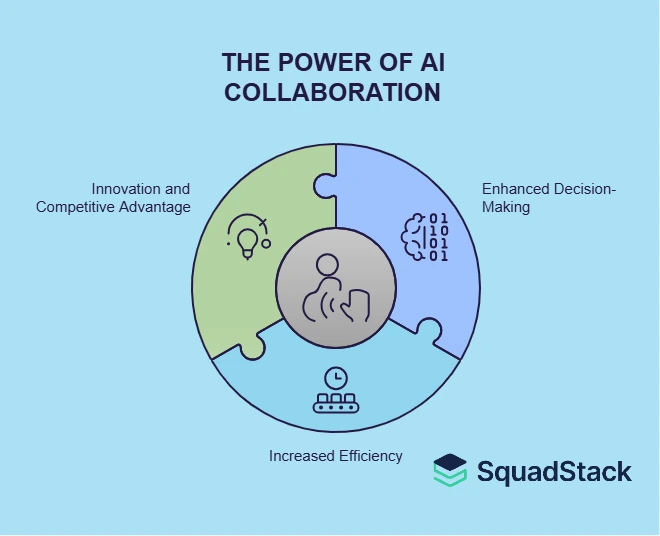Who knew that your best office partner might one day run on algorithms, never need caffeine, and thrive on data? Welcome to the world where AI collaboration is quickly helping the workplace.
Recent research shows that organisations harnessing an AI-centric collaborative strategy routinely outperform competitors, getting higher ROI, improved work quality, and significant boosts in employee engagement. The conversation has moved from asking if humans and AI can work together to how they can do so most effectively, blending analytical rigour with human intuition to drive outcomes no machine or person could achieve solo.
AI collaboration isn’t just about upgrading your tech; it’s a significant shift in our work. From top-level boardrooms to everyday customer service teams, industries like healthcare, banking, and e-commerce are embracing this human–AI partnership to tackle challenging problems, drive innovation, and stay ahead of the curve. In this, we will explore all about AI collaboration.

What is AI Collaboration?
In today’s workplaces, AI collaboration transcends traditional notions of automation to become a living partnership. This evolution merges what machines do best, unrelenting precision, tireless analysis, and pattern detection, with irreplaceable human skills like empathy, moral judgment, and creative decision-making.
Innovative organisations are already adopting models where AI doesn’t just automate tasks but meaningfully augments and amplifies human capabilities. By creating symbiotic processes, teams accelerate innovation and unlock new types of problem-solving previously out of reach.
AI collaboration describes the systematic, interactive teamwork between artificial intelligence systems and human workers. Here, the focus shifts from simply automating processes to enabling humans and AI to complement each other’s strengths.
- Humans provide context, creativity, and critical reasoning.
- AI brings computational muscle, pattern recognition, and scale.
- Teams co-design workflows where each plays to their respective strengths for optimal results.
This model redefines job roles and workplace culture, bringing efficiency and the best performance. Modern workplaces investing in AI collaboration cultivate a spirit of experimentation and adaptability, ensuring that the benefits of both humans and machines are fully realised.
Types of AI Collaboration
There’s no one-size-fits-all approach. Collaboration models range from basic tasks to advanced creation:
- Task: Routine, high-volume tasks are handed over to AI (like data entry or lead qualification).
- Co-Creative Work: AI suggests insights, content, or strategies, while humans edit, validate, or expand on them.
- AI-Assisted Decision Making: Data-driven recommendations help human experts choose the best options.
- Adaptive Automation: Both parties continuously learn and adjust based on outcomes and feedback.
Choosing the right approach depends on your organisation's maturity, culture, and goals. Understanding and selecting the ideal collaboration type accelerates adoption and maximises impact across departments.
How AI Collaboration Differs from Traditional Automation
Traditional automation focuses on handling repetitive and rule-based tasks without human intervention. AI collaboration takes it further; AI becomes a smart teammate, not just a tool.
- It adapts and improves with human feedback.
- Decisions are shared, with both AI and humans learning from each other.
- The process is constantly evolving, on needs and requirements, on real-world outcomes.
It’s not about replacing humans, it’s about working together and getting better results. While automation replaces, collaboration enhances, elevating both productivity and satisfaction. Organisations transitioning from mere automation to active collaboration see measurable improvements in agility and innovation.

Benefits of AI Collaboration in the Workplace
When AI works alongside people, the workplace becomes more productive and creative. It helps teams make quicker, smarter decisions and removes everyday roadblocks. The result? A team that keeps improving instead of just sticking to routine, always learning and getting better.
Enhanced Decision-Making and Insight Generation
Modern AI can scan and understand large amounts of data in seconds, far faster than any human. When combined with human guidance, the results shown are great:
- Quicker, smarter business decisions
- Fewer mistakes and less bias, thanks to data
- Easier testing of different strategies to reduce risk
With AI and humans working together, businesses can move faster and make more confident choices. When human intuition works with AI’s speed and accuracy, teams stop guessing and start acting with precision. It helps turn complex challenges into smart opportunities.
Increased Efficiency and Productivity
By automating repetitive and time-consuming tasks, AI frees up human employees to tackle higher-level work:
- 24/7 processing power means non-stop progress, even outside business hours.
- Streamlined workflows eliminate bottlenecks and reduce delays.
- Employees spend more time on strategy, innovation, and customer engagement.
Operational efficiency isn’t just about speed; it’s about shifting focus to what matters most, both for the company and its people. Workplaces built on AI collaboration continually achieve more, with fewer resources and less burnout.
Innovation and Competitive Advantage
Bridging human ingenuity and AI computation sparks transformative ideas that set industry trends:
- New product or service ideas derived from data-driven insights.
- Enhanced ability to pivot in rapidly changing markets.
- Real-world testing and continuous feedback keep AI Collab evolving.
This kind of collaboration isn’t just about adapting to change—it helps you stay ahead of it. When teams embrace the human–AI model, they’re not just solving today’s problems—they’re building a smarter, more innovative way to work for the future.
.webp)
Practical Applications of AI Collaboration
The impact of AI-human collaboration spans industries, transforming customer touchpoints, operational backbones, and even the fundamental nature of certain job roles. Below are some of the most exciting and high-impact, practical applications seen today. By mapping real-world use cases, businesses can better identify where collaboration will drive the greatest returns.
Healthcare and Medical Diagnosis
In healthcare, AI-powered systems serve as tireless diagnostic partners, parsing millions of data points from images, genetic testing, and patient records to suggest possible conditions.
- Early detection of diseases through image recognition and predictive modelling.
- Workflow automation for administrative burdens, letting clinicians focus on care.
- AI-assisted consultations, providing second opinions, or surfacing rare conditions.
Doctors supported by AI can diagnose faster and more accurately, improving outcomes and patient satisfaction. The efficiency gains translate into saved lives and more personalised treatments for each patient.
Manufacturing and Industry
Modern factories are adopting "cobots", collaborative robots that safely work alongside humans, rather than in fenced-off areas.
- Automation of dangerous or repetitive assembly tasks.
- Real-time monitoring of production lines for quality control.
- With on-demand flexibility, machines adapt as human workers customise output.
This blend of smart automation and skilled labour maximises both output and safety. Manufacturers leveraging AI-driven collaborations are boosting productivity and transforming industrial workspaces for the better.
Please check this page, AI Agent
Customer Service and Support
AI-driven chatbots and virtual agents now handle a majority of initial customer support queries:
- Instant responses for FAQs and routine issues.
- Multilingual interactions break down language barriers.
- Smart escalation to human agents for complex problems, preserving the “human touch”.
The shift to AI collaboration reduces costs and wait times while enhancing customer satisfaction and loyalty. Unlike static scripts, these systems learn from real conversations, getting smarter and more helpful.
.webp)
How to Advance Effective AI Collaboration
Transitioning to an AI-collaborative workplace requires more than software implementation. True transformation is cultural: leadership must actively support change, employees need training, and technology must fit business objectives.
Organisations investing effort here reap exponential rewards in long-term capability and resilience.
Leadership and Change Management
Leaders play an important role in setting the vision and removing barriers to AI adoption:
- Set clear expectations: outline how AI collaboration aligns with company goals.
- Manage resistance with transparent communication and pilot programs.
- Invest in training to upskill staff for new forms of work.
Consistent leadership buy-in and support accelerate AI integration and foster employee confidence. Organisations where executives lead by example with AI tools see faster growth.
Also, check this article, Voice Bot
Building a Team Culture Around AI
To make AI work well in your company, people need to trust it. Start by encouraging open conversations and letting teams explore AI tools without fear of messing up.
- Run team workshops to show how AI can help
- Celebrate creative ideas where humans and AI work together
- Ask for regular feedback to keep improving, and how AI fits into daily tasks
When people and AI work together toward a shared goal, the outcomes are often better and more efficient. As AI continues to shape the way we work, having a growth mindset is more important than ever.
Please check What is Conversational AI | SquadStack
Tools and Technologies Supporting Collaboration
Deploying the right tech stack is important, as it ensures the growth, seamless integration, and delivers a smooth and user-friendly experience:
- Pick AI platforms that keep your data safe and follow all the right rules.
- Go for tools that track performance and help you improve over time.
- Choose solutions that are easy to use for both people and AI.
A thoughtful technology foundation empowers collaboration, today and as business needs evolve. Periodic reviews ensure the tech stack remains relevant as organisational goals shift.
.webp)
SquadStack: AI Collaboration at Scale
No discussion of AI collaboration is complete without highlighting the platforms making it a real-world success. SquadStack stands out as a leader, having built an end-to-end solution that brings together advanced AI, analytics, and human expertise for unparalleled business results.
SquadStack’s humanoid AI agent automates up to 80% of routine interactions while seamlessly transferring complex issues to skilled human agents. It boasts real-time, multilingual support.
Leading brands have seen:
- Up to 90% reductions in customer wait times.
- 40% cost savings in customer support operations.
- 60%+ boost in customer issue resolution speed.
SquadStack’s AI agents blend omnichannel engagement, built-in security, and real-time analytics for a cohesive, future-proof customer and sales journey. Features like deep CRM integration, actionable reporting, and guided onboarding empower organisations not just to deploy AI, but to continually optimise its impact. This human-AI partnership is already driving major impact across industries like e-commerce, banking, and healthcare.
Conclusion
AI collaboration has shifted from a futuristic pipe dream to an operational imperative shaping modern business. By embracing a culture of experimentation, investing in training, and choosing the right platforms, like SquadStack, organisations enable people and AI to excel together.
The future belongs to those who stop debating if humans and AI should work together, and start championing the how.
By thoughtfully addressing challenges and scaling up proven solutions, businesses can unleash untapped performance, unleashing what’s possible when human creativity and machine intelligence become true teammates. As you plan your next move, remember: in the new era of work, the most innovative teams will be those that ask, “How can my AI colleague help us win today?”
Also check AI Call Centre








